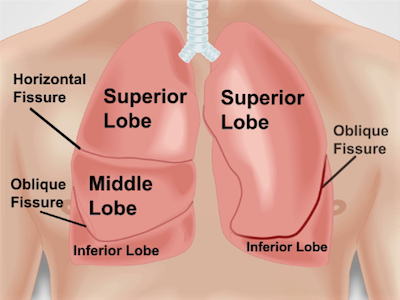호흡기 검사 II: 타악기 및 오스컬레이션
출처: Suneel Dhand,MD, 주치의, 내과, 베스 이스라엘 Deaconess 의료 센터
호흡기의 타악기 와 접종을위한 적절한 기술을 배우는 것은 매우 중요하며 실제 환자에 대한 연습과 함께 제공됩니다. 타악기는 일상적인 임상 실습 중에 종종 건너 뛰는 유용한 기술이지만 올바르게 수행하면 의사가 근본적인 폐 병리학을 식별하는 데 도움이 될 수 있습니다. Auscultation은 만성 폐쇄성 폐 질환 (COPD), 천식, 폐렴 및 폐렴을 포함한 다수의 급성 폐 질환에 대한 거의 즉각적인 진단을 제공 할 수 있습니다.
폐를 공해하는 지역은 폐 영역에 해당합니다. 각 폐 엽은 타악기 및 천양(도 1)동안가슴 벽 아래에 그려질 수 있다. 오른쪽 폐에는 우수한, 중간 및 열등한 엽의 세 가지 엽이 있습니다. 왼쪽 폐에는 두 개의 엽이 있습니다: 우수하고 열등한 엽. 좌측 폐의 우수한 엽은 또한 언어로 알려진 별도의 프로젝션을 가지고 있다.

그림 1. 흉벽에 대하여 폐의 해부학. 폐와 그들의 균열 및 엽의 대략적인 투영은 가슴 벽에 앞쪽으로 돌립니다. RUL - 오른쪽 상부 로브; RML - 오른쪽 중간 엽; RLL - 오른쪽 하부 로브; LUL - 왼쪽 상부 로브; LLL - 왼쪽 아래 엽.
1. 포지셔닝
- 환자가 허리까지 옷을 입지 않았는지 확인하십시오.
- 환자를 30-45도 각도로 검사 테이블에 배치하고 오른쪽에서 접근합니다. 폐의 후방을 검사하려면 환자가 앞으로 기대거나 침대 가장자리에 앉아 있어야합니다.
2. 타악기
- 뒤쪽에서 시작하여 후방과 전방모두에서 타악기를 타게 됩니다.
- 중간 손가락 (플렉시미터 손가락)을 누르고 환자의 오른쪽 또는 왼쪽 중간 뒤 영역 (폐의 낮은 수준)에 단단히 확장하여 비 지배적 인 손을 놓습니다. 손가락이 가슴 벽에 더 단단하게 누르면 타악기 음표가 커지는 경향이 있습니다.
- 다른 손가락과 손바닥이 환자의 가슴에 대고 누르지 않도록 하십시오.
- 지배적 인 손의 가운데 손가락 (신경병 손가락)의 끝을 사용하여 적어도 두 번 (손톱을 짧게 유지하는 것이 좋습니다)의 플렉시미터 손가락의 상단 세 번째 (중간 또는 실외 지골)를 단
타악기와 공해는 완전한 호흡 검사를 수행할 때마다 항상 순서대로 수행해야 합니다. 타악기를 올바르게 학습하는 방법에는 시간과 연습이 필요합니다(연습은 테이블과 같은 다른 표면에서 수행할 수 있습니다). 타악기 노트가 공기가 채워진 폐, 갈비뼈 및 심장과 같은 고체 장기를 통해 자연스럽게 어떻게 변하는지 유의하십시오.
Auscultation은 의사에게 어떤 폐 병리학의 초?...
건너뛰기...
이 컬렉션의 비디오:

Now Playing
호흡기 검사 II: 타악기 및 오스컬레이션
Physical Examinations I
211.2K Views

신체 시험에 대한 일반적인 접근 방식
Physical Examinations I
115.1K Views

관찰 및 검사
Physical Examinations I
92.9K Views

촉진
Physical Examinations I
82.4K Views

타악기
Physical Examinations I
99.2K Views

청진
Physical Examinations I
60.0K Views

신체 검사 중 환자 복장의 적절한 조정
Physical Examinations I
82.8K Views

혈압 측정
Physical Examinations I
106.7K Views

활력 징후 측정
Physical Examinations I
113.5K Views

호흡기 검사 I: 검사 및 촉진
Physical Examinations I
155.6K Views

심장 검사 I: 검사 및 촉진
Physical Examinations I
175.0K Views

심장 검사 II: Auscultation
Physical Examinations I
138.9K Views

심장 검사 III: 비정상적인 심장 소리
Physical Examinations I
91.1K Views

말초 혈관 시험
Physical Examinations I
67.6K Views

연속 파 도플러를 이용한 말초 혈관 시험
Physical Examinations I
38.3K Views
Copyright © 2025 MyJoVE Corporation. 판권 소유